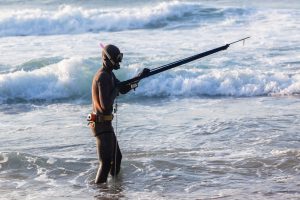Why you need a speargun in your preps

Spearfishing is the ultimate adventure sport.
You’re in the water, using your skills, training, and expertise to bring home fish, after fish, after fish. And there’s nothing better than a regular supply of fresh seafood.
My childhood was spent by the beach.
Fishing rod in hand, I had many days wasted as I came home empty-handed. The fish weren’t biting. We ran out of bait. A thousand reasons why I didn’t catch anything.
Until I started spearfishing.
Armed with the right gear, I was able to hunt in an area previously out of reach. I was able to find the fish that weren’t biting, and land them with my spear.
Over the years, I’ve caught several thousand dollars worth of fresh seafood, much to the delight of my friends and family. But not only that.
In a crisis, I know I’ve got the means to put food on the table. I know that after a couple of hours in the water I’ll bring in enough fresh seafood to keep them fed, happy, and thriving, no matter what the world has decided to throw our way.
 Because I don’t want to rely on anyone. Not the supermarket. Not the butcher. In a disaster, you’ve got to find ways to become self-sufficient, so you’re not left high-and-dry when the supply runs stop. It’s the only way to guarantee your family’s well-being.
Because I don’t want to rely on anyone. Not the supermarket. Not the butcher. In a disaster, you’ve got to find ways to become self-sufficient, so you’re not left high-and-dry when the supply runs stop. It’s the only way to guarantee your family’s well-being.
And spearfishing gives you the means to do it.
Sound interesting? Good. Here’s what you need to know.
How to start spearfishing?
First, let me explain a little about the concept. What you’re doing is essentially a form a snorkeling, where you’re armed with a speargun to shoot the fish you’re seeing. It puts you in charge, allowing you to find, stalk and catch the perfect fish that your family needs. There are a few key pieces of gear you’ll need, namely a speargun, a mask and snorkel and a pair of flippers. I’d also recommend getting a wetsuit and a weight belt, gloves and a dive knife. Of course, choosing a speargun can be a challenge as there are so many options, but I’ve made some recommendations to help you in my guide to the best spearguns. Once you’ve got your gear you just need to head down to the coast and find a calm piece of ocean. Jump in and start swimming around.
Hang on, where am I meant to do this?
For a beginner that’s new to spearfishing, my advice is to start from the shore. You want to find a bit of ocean that’s protected from the waves and the wind, gear up and jump right in. I’ve found that there are far more fish underwater than most people realize, especially if there’s a little bit of structure, like along a rock wall, or a shallow reef. The ocean is teeming with life, you just need to get in there and start looking around. But a word of warning. The ocean can be unsafe, with strong currents and sharp reefs. Make sure you’ve checked the forecasts, and you’re not swimming out into an area that’s unsafe.
Right, now onto the fish. What can I catch?
Depending on the part of the country you’re living in, there will be a wide variety of different fish. But before you get too far, make sure you know the local fishing regulations, sizes and bag limits for your state. The last thing you want is a fine because you’ve shot a small fish, or killed a protected species. There will also be guidance on particular areas you’re not allowed with your speargun, so do your research and don’t break the rules. Once you’re in the water remember fish will look a little larger at a distance (so pick the truly big ones to shoot), and don’t be afraid to swim around to different depths and areas. It’ll take time until you learn where fish like to hang about.
The ambush technique to land your first fish
Whilst there’s no right or wrong way to spearfish, I’ve had the most luck with a technique I like to call the ambush. It works like this. Swim around until you find a particular area of the reef that has some good-sized target fish. Take a deep breath, and dick-dive down to the bottom. Your weights will help you stay in place, but you can also grab hold of a rock or some seaweed if the current is a little strong. Then just stay still until a fish comes close. They will. Fish are curious. Your goal is to remain calm, and let them come close. Once they do, extend your arm and the speargun slowly, turn the safety off and take your shot. A good range is anywhere from 3 to 7 feet, and you want to aim at the point where the spine connects to the fish’s head. A good shot will “stone” the fish (killing it on impact), and you can now surface, and put the fish on your stringer.
Ok, but this will bring sharks, right?
Yes. Sharks are always around, and every now and then you may have an encounter with one. But in all my years I’ve got one piece of advice. The shark isn’t after you. It’s after the fish. If a shark comes in close and is a little too aggressive, give them your fish. You don’t want to get in a fight with one of the biggest predators in the ocean. Mostly though, the sharks are just curious as to what you are, and what you’re doing in their water. I just use my speargun to “push” them away, a bit of a prod on their nose won’t do any damage, but it can be a nice incentive to get a shark to back off and give you a little distance.
What else do I need to know?
We touched on this earlier, but it’s important so I want to cover it in detail. When you’re in the ocean you need to be careful. There’re strong currents that can be impossible to swim against, but not only that, your worst enemy when you’re spearfishing is other people. The ones driving the boats. You’re actually quite difficult to see when you’re spearfishing, which is why many states recommend using a Diver Below float and flag. It’ll help them see you. I’d also recommend never going spearfishing alone. Get your partner involved, or find a friend who can join, as they can also help to keep an eye on you. The key is to be smart, and not push your limits too far, especially when you’re just getting started.
When it all comes down to it, being prepared is more about what you know, than what you have. Armed with the right gear, and a little knowledge about spearfishing in your local area, you can ensure you’ve got a constant supply of fresh seafood for your family, no matter what happens. So, buy a speargun and learn how to catch your own meals. That way, you’ll be a provider for your family no matter what.
![]()
About the Author
 I live for the water. Chasing the next biggest fish. That perfect day on the ocean. The buzz that comes from coming face to face with true underwater giants. I’ve been hooked on spearfishing since I was 15, and have spent every spare weekend in my wetsuit, finding new dive sites, testing new gear, and honing my skills at this sport. It’s almost an obsession, and I’d love to help you get involved in spearfishing, and maybe help you catch a fish or two in the process. Happy spearing! ~ Max Kelley
I live for the water. Chasing the next biggest fish. That perfect day on the ocean. The buzz that comes from coming face to face with true underwater giants. I’ve been hooked on spearfishing since I was 15, and have spent every spare weekend in my wetsuit, finding new dive sites, testing new gear, and honing my skills at this sport. It’s almost an obsession, and I’d love to help you get involved in spearfishing, and maybe help you catch a fish or two in the process. Happy spearing! ~ Max Kelley
Images and content courtesy of Max Kelley of Max Spearfishing.
--
